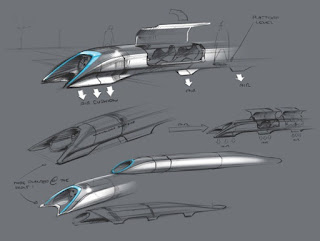Please Wait...
Space drones
NASA has challenged designers to develop a conventional
drone to work inside a space station, navigating with no ‘up’ or ‘down’. The
winning design, ArachnoBeeA, would use cameras and tiny beacons to manoeuvre
its way around. How popular drones would be in such a confined space is a
different question.
760mph trains
Hate commuting? Imagine, instead, your train carriage
hurtling down a tunnel at the same speed as a commercial jet airliner. That’s
the dream of PayPal, Tesla and SpaceX founder Elon Musk. His Hyperloop system
would see ‘train’ passengers travel at up to 760mph through a vacuum tube,
propelled by compressed air and induction motors. A site has been chosen with
the goal of starting test runs in two years. Once built, the loop will ferry
passengers between San Francisco and LA in 35 minutes, compared to 7.5 hours by
train.
Drown forest fires in sound
Forest fires could one day be dealt with by drones that would
direct loud noises at the trees below. Since sound is made up of pressure
waves, it can be used to disrupt the air surrounding a fire, essentially
cutting off the supply of oxygen to the fuel. At the right frequency, the fire
simply dies out, as researchers at George Mason University in Virginia recently
demonstrated with their sonic extinguisher. Apparently, bass frequencies work
best.
The AI scientist
Cut off a flatworm’s head, and it’ll grow a new one. Cut it
in half, and you’ll have two new worms. Fire some radiation at it, and it’ll
repair itself. Scientists have wanted to work out the mechanisms involved for
some time, but the secret has eluded them. Enter an AI coded at Tufts
University, Massachusetts. By analysing and simulating countless scenarios, the
computer was able to solve the mystery of the flatworm’s regeneration in just
42 hours. In the end it produced a comprehensive model of how the flatworm’s
genes allow it to regenerate.
Although humans still need to feed the AI with information,
the machine in this experiment was able to create a new, abstract theory
independently – a huge step towards the development of a conscious computer,
and potentially a landmark step in the way we carry out research.
Space balloon
If you want to take a trip into space, your quickest bet
might be to take a balloon. The company World View Enterprises wants to send
tourists into the stratosphere, 32km above Earth, on hot air balloons.
Technically ‘space’ is defined as 100km above sea level, but 32km is high
enough to witness the curvature of the Earth, just as Felix Baumgartner did on
his space jump. The balloon flew its first successful test flight in June, and
the company will start selling tickets in 2016 – at the bargain price of just
£75,000 per person!
Breathalyser cars
The US National Highway Traffic Safety Administration has
developed devices that can monitor alcohol levels by sniffing a driver’s breath
or scanning the blood in their fingertips via the steering wheel, immobilising
the car if levels are too high. Drivers using the system could be offered lower
insurance premiums.
Internet for everyone
After Tesla and SpaceX, PayPal founder Elon Musk is turning
his attention back to the internet: he’s awaiting permission to send almost
4,000 small satellites into low-Earth orbit that would beam back a high-speed
wireless signal to everyone on the planet. And things are moving fast: Musk
hopes to launch a series of test satellites in 2016, with a view to completing
the project by 2020. He has competition to get there first though, as British
billionaire Richard Branson also wants to cover the world with wi-fi.
Personalities for robots
Google has obtained a patent on robot personalities,
reminiscent of the ‘Genuine People Personalities’ of robots in The Hitchhiker’s
Guide To The Galaxy. Owners could have a personality automatically chosen to
match their needs, or select one based on a fictional character or even a loved
one. Although the patent was announced suspiciously close to April 1, it does
exist (US Patent 8,996,429), and with our natural tendency to anthropomorphism
it seems a likely development.
Human head transplants
Sergio Canavero , an Italian neurosurgeon, intends to
attempt the first human head transplant by 2016, though no successful animal
transplants with long-term survival have yet been made. Because of the
difficulty of connecting the spinal cord, Canavero has suggested improvements
in the process using a special blade and polyethylene glycol, a polymer used in
medicine as well as in everything from skin cream to the conservation of the
Mary Rose, can help start growth in spinal cord nerves.
Other experts say Canavero is wildly optimistic, but we can
at least expect improved ability to repair damaged spinal cords over the next
decade, restoring body function to some spinal injury patients.
Your brain print as a password
Could your brainwaves function as your computer password? A
team at Binghamton University, New York, looked at the way volunteers’ brain
signals changed as they read a list of acronyms. Each person reacted
differently enough for the system to predict who was reading the list with 94
per cent accuracy. In future, a honed version of this idea could verify who is
sitting at a PC.
Source"http://www.sciencefocus.com/feature/future/future-technology-22-ideas-about-change-our-world"



